#NGC 6726
Photo

Dust & Stars in Corona Australis
#stars#space#nasa#ngc 6726#universe#galaxy#planet#astronomy#planets#astrophotography#nebula#solar system#night sky#cosmos#corona australis
3K notes
·
View notes
Text

The Corona Australis Molecular Cloud // Ogetay Kayali
Note the globular cluster NGC 6723 projected near the cloud!
#astronomy#astrophotography#nebula#dark nebula#reflection nebula#dust#interstellar dust#molecular cloud#corona australis molecular cloud#NGC 6729#NGC 6727#NGC 6726#stars#star cluster#globular cluster#NGC 6723#corona australis
118 notes
·
View notes
Photo

2023 June 22
Stars and Dust across Corona Australis
Image Credit & Copyright: Alessandro Cipolat Bares
Explanation: Cosmic dust clouds cross a rich field of stars in this telescopic vista near the northern boundary of Corona Australis, the Southern Crown. Part of a sprawling molecular cloud complex this star forming region is a mere 500 light-years away. That's about one third the distance of the more famous stellar nursery known as the Orion Nebula. The 2 degree wide frame would span 15 light-years at the clouds' estimated distance. Mixed with bright nebulosities the dust clouds effectively block light from more distant background stars in the Milky Way and obscure from view embedded stars still in the process of formation. Large dark nebula Bernes 157 is on the left. To its right are a group of pretty reflection nebulae cataloged as NGC 6726, 6727, 6729, and IC 4812. Their characteristic blue color is produced as light from hot stars is reflected by the cosmic dust. The more compact NGC 6729 surrounds young variable star R Coronae Australis. Just below it, filamentary arcs and loops are identified as Herbig Haro objects associated with energetic newborn stars. In fact, at the heart of this area lies the Coronet Cluster, one of the nearest and most active star forming regions.
∞ Source: apod.nasa.gov/apod/ap230622.html
73 notes
·
View notes
Photo
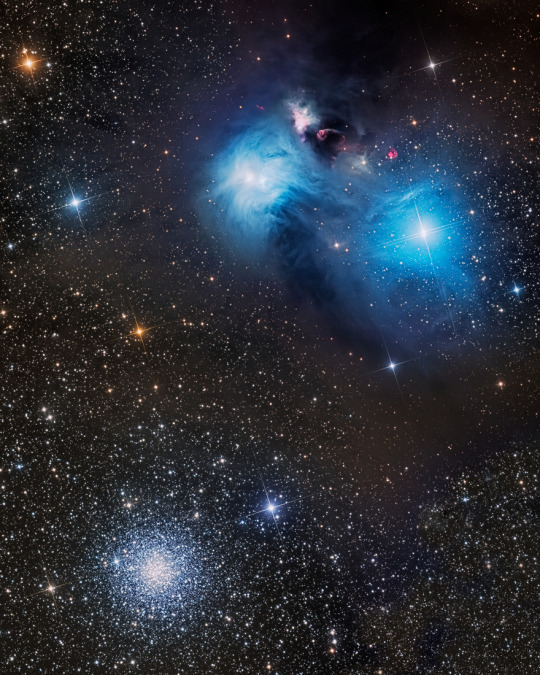
Stars and Dust Across Corona Australis : Cosmic dust clouds cross a rich field of stars in this telescopic vista near the northern boundary of Corona Australis, the Southern Crown. Less than 500 light-years away the dust clouds effectively block light from more distant background stars in the Milky Way. Top to bottom the frame spans about 2 degrees or over 15 light-years at the clouds' estimated distance. At top right is a group of lovely reflection nebulae cataloged as NGC 6726, 6727, 6729, and IC 4812. A characteristic blue color is produced as light from hot stars is reflected by the cosmic dust. The dust also obscures from view stars in the region still in the process of formation. Just above the bluish reflection nebulae a smaller NGC 6729 surrounds young variable star R Coronae Australis. To its right are telltale reddish arcs and loops identified as Herbig Haro objects associated with energetic newborn stars. Magnificent globular star cluster NGC 6723 is at bottom left in the frame. Though NGC 6723 appears to be part of the group, its ancient stars actually lie nearly 30,000 light-years away, far beyond the young stars of the Corona Australis dust clouds. via NASA
954 notes
·
View notes
Text
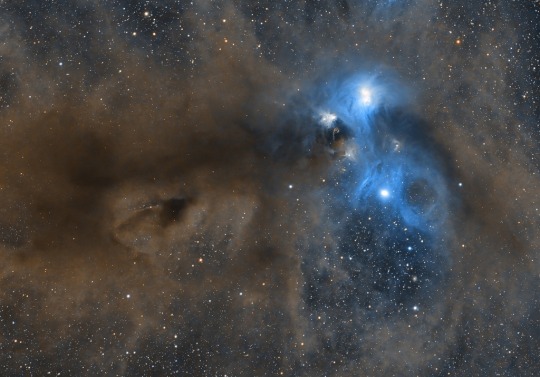
APOD: Stars and Dust across Corona Australis (6/22/23)
Cosmic dust clouds cross a rich field of stars in this telescopic vista near the northern boundary of Corona Australis, the Southern Crown. Part of a sprawling molecular cloud complex this star forming region is a mere 500 light-years away. That's about one third the distance of the more famous stellar nursery known as the Orion Nebula. The 2 degree wide frame would span 15 light-years at the clouds' estimated distance. Mixed with bright nebulosities the dust clouds effectively block light from more distant background stars in the Milky Way and obscure from view embedded stars still in the process of formation. Large dark nebula Bernes 157 is on the left. To its right are a group of pretty reflection nebulae cataloged as NGC 6726, 6727, 6729, and IC 4812. Their characteristic blue color is produced as light from hot stars is reflected by the cosmic dust. The more compact NGC 6729 surrounds young variable star R Coronae Australis. Just below it, filamentary arcs and loops are identified as Herbig Haro objects associated with energetic newborn stars. In fact, at the heart of this area lies the Coronet Cluster, one of the nearest and most active star forming regions.
© Alessandro Cipolat Bares
0 notes
Photo

Stars and Dust across Corona Australis via NASA https://ift.tt/ORNFxra Cosmic dust clouds cross a rich field of stars in this telescopic vista near the northern boundary of Corona Australis, the Southern Crown. Part of a sprawling molecular cloud complex this star forming region is a mere 500 light-years away. That's about one third the distance of the more famous stellar nursery known as the Orion Nebula. The 2 degree wide frame would span 15 light-years at the clouds' estimated distance. Mixed with bright nebulosities the dust clouds effectively block light from more distant background stars in the Milky Way and obscure from view embedded stars still in the process of formation. Large dark nebula Bernes 157 is on the left. To its right are a group of pretty reflection nebulae cataloged as NGC 6726, 6727, 6729, and IC 4812. Their characteristic blue color is produced as light from hot stars is reflected by the cosmic dust. The more compact NGC 6729 surrounds young variable star R Coronae Australis. Just below it, filamentary arcs and loops are identified as Herbig Haro objects associated with energetic newborn stars. In fact, at the heart of this area lies the Coronet Cluster, one of the nearest and most active star forming regions.
0 notes
Photo

NGC 6726
#NGC 6726#nasa#stargazing#astrophoto#astrophotography#galaxy#astronomy#universe#space#nebula#spinningblueball#milky way#milky way galaxy#star
131 notes
·
View notes
Photo

(NASA) Stars and Dust in Corona Australis
Image Credit & Copyright: Eric Coles & Martin Pugh
Blue dust clouds and young, energetic stars inhabit this telescopic vista, less than 500 light-years away toward the northern boundary of Corona Australis, the Southern Crown. The dust clouds effectively block light from more distant background stars in the Milky Way. But the striking complex of reflection nebulas cataloged as NGC 6726, 6727, and IC 4812 produce a characteristic blue color as light from the region's bright blue stars is reflected by the cosmic dust. The dust also obscures from view stars still in the process of formation. At the left, smaller yellowish nebula NGC 6729 bends around young variable star R Coronae Australis. Just below it, glowing arcs and loops shocked by outflows from embedded newborn stars are identified as Herbig-Haro objects. On the sky this field of view spans about one degree, corresponding to almost nine light-years at the estimated distance of the nearby star forming region.
Source
#astronomy#reflexion nebulas#NGC 6726#NGC 6727#IC 4812#nebula NGC 6729#Corona Australis/Southern Crown
2 notes
·
View notes
Photo
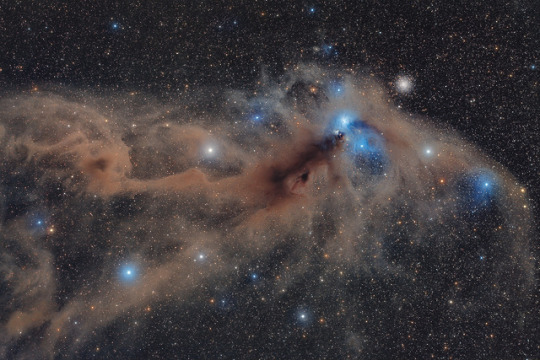
“Corona Australis Dust Complex”
© Mario Cogo
#art#photography#astrophotography#nebula#stars#cosmic#cosmos#universe#dust#mario cogo#molecular#corona australis#NGC 6726-27-29#bernes 157#CRA MOLECULAR COMPLEX
4 notes
·
View notes
Photo

NGC 6726, Corona Australis
#Astronomy#NASA#Night#Sky#Stars#Space#Science#Universe#Cosmos#Cosmic#Solar System#Corona Australis#Nebula#Galaxy#Constellations#Constellation#Rainbow#Bright
952 notes
·
View notes
Photo
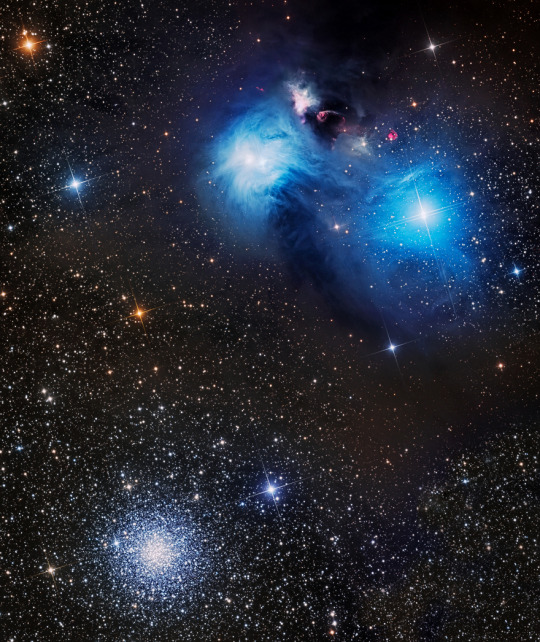
Cosmic dust clouds and stars across Corona Australis NGC 6726
#nasa#astronomy#picture of the day#space#stars#galaxy#corona australis#planet#nebula#solar system#planets#astrophotography#nebulae#science#APOD#galaxies#ngc 6726
674 notes
·
View notes
Photo

Corona Australis Boyunca Yıldızlar ve Toz
Günün Astronomi Görseli 6 Ağustos 2021
Görsel & Telif: Vikas Chander
Güney Haçı’nın (Corona Australis) kuzey sınırı yakınlarından bu teleskobik manzarada, kozmik toz bulutları zengin bir yıldız bölgesinden geçiyor. 500 ışık yılından daha yakındaki toz bulutları, Samanyolu’nda daha uzaktaki arka plan yıldızlarından gelen ışığı engelliyor. Kare tepeden tabana 2 derece, ya da bulutların tahmini mesafesinde 15 ışık yılından fazla yer kaplıyor. En üst sağda NGC 6726, 6727, 6729 ve IC 4812 olarak kataloglanan bir grup yansı nebulası var. Sıcak yıldızların ışığı kozmik toz tarafından yansıtılırken karakteristik bir mavi renk üretiliyor. Toz aynı zamanda bölgede hala oluşum sürecinde olan yıldızların görüntüsünü de engelliyor. Mavi yansı nebulalarının hemen üzerinde, daha küçük NGC 6729, genç değişen yıldız R Coronae Australis’i çevreliyor. Onun sağında, enerjik yeni doğmuş yıldızlarla ilişkili, Herbig-Haro cisimleri olarak tanımlanan kırmızımsı yaylar ve düğümler bulunuyor. Muhteşem küresel yıldız kümesi NGC 6723, karede sol altta yer alıyor. NGC 6723 grubun parçası gibi görünse de kadim yıldızları aslında neredeyse 30.000 ışık yılı uzakta, Güney Haçı toz bulutlarının çok ötesindeler.
Görsel & Telif: Vikas Chander
Yazarlar & Editörler: Robert Nemiroff (MTU) & Jerry Bonnell (UMCP) NASA yetkilisi: Phillip Newman Özel haklara tabidir. NASA Web Gizlilik Politikası ve Önemli Bildirimler Bir ASD at NASA / GSFC & Michigan Tech. U. hizmetidir.
Corona Australis Boyunca Yıldızlar ve Toz yazısı ilk olarak Uzaydan Haberler sayfasında göründü.
2 notes
·
View notes
Photo
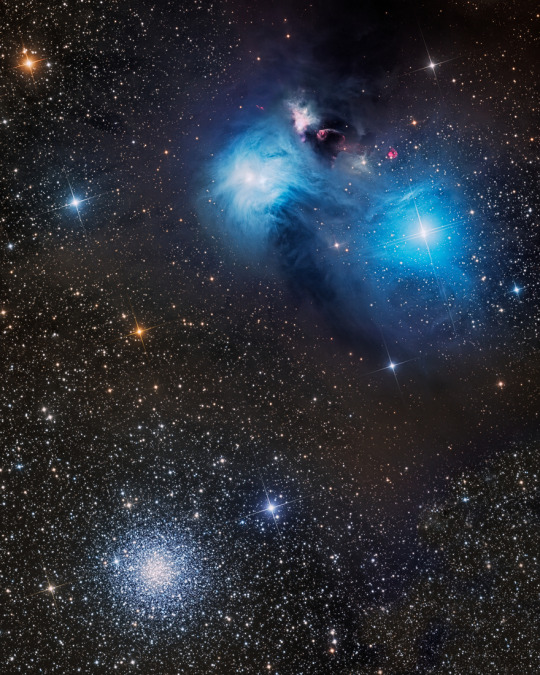
2021 August 6
Stars and Dust Across Corona Australis
Image Credit & Copyright: Vikas Chander
Explanation: Cosmic dust clouds cross a rich field of stars in this telescopic vista near the northern boundary of Corona Australis, the Southern Crown. Less than 500 light-years away the dust clouds effectively block light from more distant background stars in the Milky Way. Top to bottom the frame spans about 2 degrees or over 15 light-years at the clouds' estimated distance. At top right is a group of lovely reflection nebulae cataloged as NGC 6726, 6727, 6729, and IC 4812. A characteristic blue color is produced as light from hot stars is reflected by the cosmic dust. The dust also obscures from view stars in the region still in the process of formation. Just above the bluish reflection nebulae a smaller NGC 6729 surrounds young variable star R Coronae Australis. To its right are telltale reddish arcs and loops identified as Herbig Haro objects associated with energetic newborn stars. Magnificent globular star cluster NGC 6723 is at bottom left in the frame. Though NGC 6723 appears to be part of the group, its ancient stars actually lie nearly 30,000 light-years away, far beyond the young stars of the Corona Australis dust clouds.
∞ Source: apod.nasa.gov/apod/ap210806.html
180 notes
·
View notes
Photo
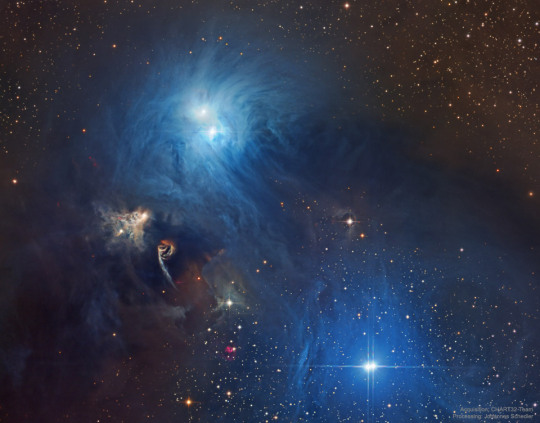
Stars and Dust in Corona Australis : Cosmic dust clouds and young, energetic stars inhabit this telescopic vista, less than 500 light-years away toward the northern boundary of Corona Australis, the Southern Crown. The dust clouds effectively block light from more distant background stars in the Milky Way. But the striking complex of reflection nebulae cataloged as NGC 6726, 6727, and IC 4812 produce a characteristic blue color as light from the region's young hot stars is reflected by the cosmic dust. The dust also obscures from view stars still in the process of formation. At the left, smaller yellowish nebula NGC 6729 bends around young variable star R Coronae Australis. Just below it, glowing arcs and loops shocked by outflows from embedded newborn stars are identified as Herbig-Haro objects. On the sky this field of view spans about 1 degree. That corresponds to almost 9 light-years at the estimated distance of the nearby star forming region. via NASA
680 notes
·
View notes
Text

APOD: Stars and Dust across Corona Australis (6/22/23)
Cosmic dust clouds cross a rich field of stars in this telescopic vista near the northern boundary of Corona Australis, the Southern Crown. Part of a sprawling molecular cloud complex this star forming region is a mere 500 light-years away. That's about one third the distance of the more famous stellar nursery known as the Orion Nebula. The 2 degree wide frame would span 15 light-years at the clouds' estimated distance. Mixed with bright nebulosities the dust clouds effectively block light from more distant background stars in the Milky Way and obscure from view embedded stars still in the process of formation. Large dark nebula Bernes 157 is on the left. To its right are a group of pretty reflection nebulae cataloged as NGC 6726, 6727, 6729, and IC 4812. Their characteristic blue color is produced as light from hot stars is reflected by the cosmic dust. The more compact NGC 6729 surrounds young variable star R Coronae Australis. Just below it, filamentary arcs and loops are identified as Herbig Haro objects associated with energetic newborn stars. In fact, at the heart of this area lies the Coronet Cluster, one of the nearest and most active star forming regions.
© Alessandro Cipolat Bares
0 notes
Photo

Blue Reflection Nebulae NGC 6726, NGC 6727, and IC 4812 Yellow Nebula NGC 6729 and R Coronae Australis
#Blue Reflection Nebulae#NGC 6726#NGC 6727#IC 4812#Yellow Nebula#NGC 6729#Coronae Australis#nasa#stargazing#astrophoto#astrophotography#galaxy#astronomy#universe#space#nebula#spinningblueball#milky way#milky way galaxy#star
268 notes
·
View notes